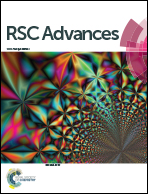Highly effective utilization of ethylene tar for mesophase development via a molecular fractionation process†
Abstract
Ethylene tar (ET) is a bulk chemical by-product from the ethylene industry. Realizing effective utilization of ET will have great significance to both economic and environmental benefits. In this paper, a facile molecular fractionation process is proposed for the effective utilization of ET and for the development of flow-domain textured mesophase pitches. Through vacuum distillation, ET was separated into the light fraction (LF) and the heavy cut (HC), in which the LF rich in alkylated benzenes, naphthalene and methylnaphthalene could be refined to produce useful chemicals, and the HC residuals could serve as good precursors for high-valued mesophase pitches. It was found that the distillation temperature strongly affected the HC's components especially the content of cata-condensed and peri-condensed compounds, resulting in different feasibilities for mesophase development. HC obtained at a distillation temperature of 250 °C demonstrated the best ability for quick formation and coalescence of the mesophase, which thus was chosen as the precursor for mesophase pitch preparation. Furthermore, a series of operating conditions including temperature, duration and pressure (pressurization and depressurization) were systematically optimized. High performance mesophase pitch with high softening point, high carbon yield, low ash content and 100% anisotropy of flow domain texture was successfully produced under ambient conditions at 400 °C for a duration of 12 h.


 Please wait while we load your content...
Please wait while we load your content...